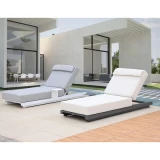Creating Your Perfect Outdoor Oasis: Tips for Choosing Outdoor Furniture
2024-08-24
Transforming your outdoor space into a comfortable and stylish retreat involves selecting the right outdoor furniture. Whether you’re designing a cozy patio, a lively deck, or a serene garden, the furniture you choose plays a crucial role in enhancing the functionality and aesthetics of your space. Here’s a guide to help you choose the perfect outdoor furniture for your home.
1. Assess Your Space
Before selecting outdoor furniture, it’s important to evaluate your space to ensure you choose pieces that fit well and suit your needs:
Measure Your Area: Start by measuring the dimensions of your outdoor space. Consider both the length and width of the area to determine what size furniture will fit comfortably.
Consider the Layout: Think about how you plan to use the space. Do you want a dining area, a lounge area, or a combination of both? Plan the layout accordingly to ensure you have enough room for movement and additional features like plants or lighting.
2. Choose the Right Material
Outdoor furniture comes in a variety of materials, each with its own advantages and maintenance requirements. Here are some common options:
Wood: Classic and stylish, wooden furniture adds warmth to any outdoor space. Teak, cedar, and eucalyptus are popular choices due to their durability and resistance to weather elements. Regular maintenance, such as sealing and cleaning, helps preserve the wood’s appearance.
Metal: Metal furniture, including aluminum and wrought iron, offers a modern and sleek look. Aluminum is lightweight and resistant to rust, while wrought iron is more robust but may require periodic painting to prevent corrosion.
Plastic and Resin: These materials are often designed to mimic the look of wood or wicker. They are lightweight, easy to clean, and resistant to weather conditions. Plastic and resin furniture are typically more affordable and require minimal maintenance.
Wicker and Rattan: Wicker and rattan furniture offer a classic, natural look. Made from woven fibers, these pieces are often lightweight and comfortable. Look for furniture with synthetic wicker or rattan for better durability and weather resistance.
3. Consider Comfort and Functionality
Comfort and functionality are key factors when choosing outdoor furniture:
Cushions and Upholstery: Opt for cushions with outdoor-grade fabric that resists moisture, UV rays, and mildew. Removable and washable covers are ideal for easy maintenance.
Adjustable Features: Consider furniture with adjustable features, such as reclining chairs or extendable tables, to enhance comfort and adaptability.
Storage Solutions: If space is limited, look for furniture with built-in storage, such as benches with hidden compartments or tables with shelves.
4. Match Your Style
Your outdoor furniture should complement the overall style of your home and outdoor space:
Traditional: For a classic look, choose furniture with intricate designs and warm wooden finishes. Accessories like patterned cushions and lanterns can enhance the traditional vibe.
Modern: Opt for sleek, minimalist furniture with clean lines and neutral colors. Metal or plastic materials with geometric shapes can contribute to a modern aesthetic.
Coastal: Embrace a relaxed, beachy feel with furniture in light, airy colors and materials like wicker or teak. Add nautical-themed accessories for a cohesive coastal look.
Bohemian: For a bohemian style, mix and match colorful textiles, eclectic patterns, and natural materials. Consider adding throw pillows, rugs, and hanging lights for a boho-chic vibe.
5. Maintain and Care for Your Furniture
Proper maintenance ensures your outdoor furniture remains in good condition:
Regular Cleaning: Clean your furniture regularly to remove dirt and debris. Use mild soap and water for most materials, and follow manufacturer instructions for specific cleaning requirements.
Protective Covers: Use furniture covers or store furniture in a dry place during harsh weather conditions to extend its lifespan.
Seasonal Care: For wooden furniture, apply sealant or oil periodically to protect against moisture and sun damage. Metal furniture may require touch-ups with paint to prevent rust.
6. Budget Considerations
Outdoor furniture comes in a wide range of price points. Determine your budget and look for pieces that offer the best value for your money. Remember that investing in high-quality furniture can provide long-term durability and comfort.
In conclusion, choosing the right outdoor furniture involves considering factors such as space, material, comfort, style, and maintenance. By carefully selecting pieces that meet your needs and preferences, you can create a beautiful and functional outdoor space that enhances your enjoyment and relaxation.



